We began our coverage of Skyharbour Resources (SYH.V) back on June 9th in a piece titled Skyharbour Resources (SYH.V) an Athabasca Basin Uranium gem in the midst of an aggressive drill campaign.
This cash-rich Athabasca Basin land baron has a number of highly prospective irons in the fire—a strapping project pipeline—in a region that boasts the highest-grade uranium deposits on the planet. The Basin has been historically responsible for approx 20% of the world’s primary uranium supply. This mining-friendly jurisdiction—the Canadian province of Saskatchewan—is ranked in the Top Three according to the Fraser Institute’s Investment Attractiveness Index.
The 35,705 hectare Moore Lake Uranium Project, in the southeast corner of the Basin, is the Company’s flagship.
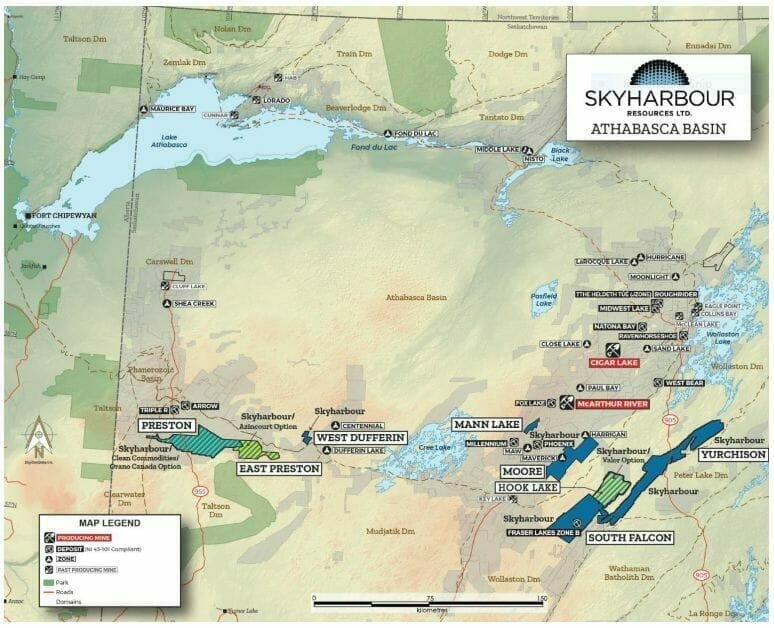
Located approximately 15 kilometers east of Denison Mine’s Wheeler River project (Denison is a strategic partner), Moore Lake is strategically positioned in a region rich with infrastructure.
On June 16th, the Company announced an acceleration in its current drill campaign at Moore Lake, from 3,500 meters to 5,000 meters—Skyharbour Expands its Current Drill Program at its High Grade Moore Uranium Project, Saskatchewan.
This fully-funded program, designed to follow up on existing unconformity and basement-hosted targets along the high-grade Maverick structural Corridor, will also probe newly defined targets along the Grid Nineteen area.
In a June 16th Equity Guru piece titled Skyharbour (SYH.V) accelerates Moore Lake drill campaign in the prolific Athabasca Basin, we stated:
“Skyharbour announced that its drilling program at Moore Lake is progressing well and has produced sufficient encouragement to warrant an acceleration in the current campaign. I’m guessing the onsite geos like what they’re seeing coming out of the ground—they like the core.”

For the remaining properties in this highly prospective project pipeline—I count six projects in the Basin alone—the Company (wisely) employs the prospect generator business model to push things further along the exploration and development curve.
Multiple irons in the fire equal multiple shots at a significant new discovery.
On July 6th, partner company Azincourt Energy provided an update regarding a summer exploration campaign at the East Preston Uranium Project located along the western side of the Basin.
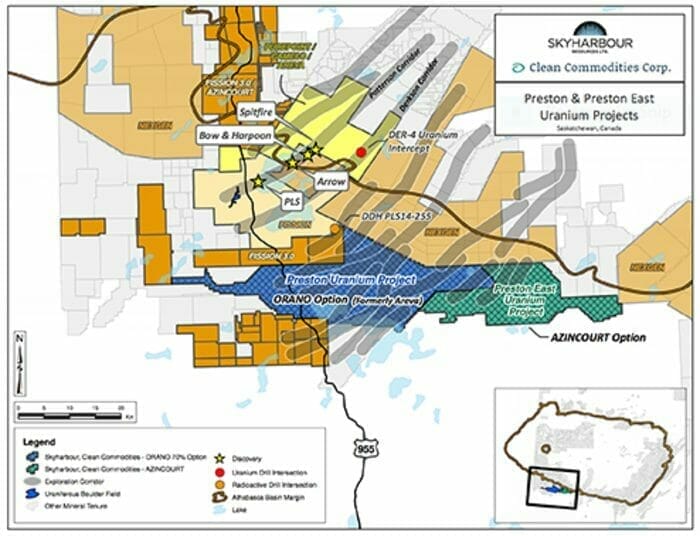
In a July 7th Equity Guru piece covering that news event, we reported the following:
“Planning is currently underway for a late summer/early fall diamond drill campaign of roughly 1,000 meters—meters that were originally scheduled for the 2021 winter program.
This July 6th press release goes on to state that an extensive 6,000-meter campaign consisting of 25-30 drill holes is on deck for the winter of 2022. Drill targets will be further prioritized with the data assembled this summer.”
Another one of Skyharbour’s partners is mobilizing field crews to the Athabasca Basin as I type this piece.
Back in December of 2020, Skyharbour entered into a strategic partnership with ASX-listed Valor Resources that can earn an 80% interest in the 25,846-hectare Hook Lake Project by contributing cash and exploration expenditures totaling $3,975,000 over three years ($475,000 in cash and $3,500,000 in exploration commitments).
To seal this deal, Valor was also required to issue 233,333,333 shares to Skyharbour, upfront.
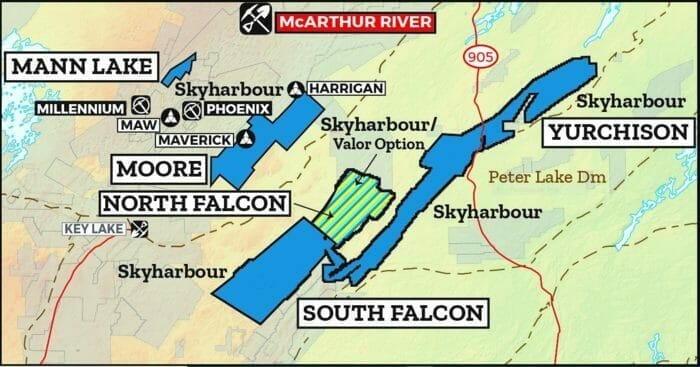
The exploration upside at Hook Lake—the potential for a significant discovery—is heightened by a batch of uber high-grade grab samples plucked from the north end of the property.
“In October 2015, on the northern side of the property at the Hook Lake target, Skyharbour reported that it had confirmed the presence of high-grade uranium mineralization with up to 68.0% U3O8 in a grab sample from a trench. The trench is referred to as the Hook Lake U-Mo showing and was the focus of the Company’s Summer 2015 field program which consisted of detailed prospecting and vegetation sampling. Skyharbour randomly selected three grab samples from the Hook Lake showing to verify historic results and these grab samples returned 68.0% U3O8, 35.7% U3O8 and 29.8% U3O8.”
Those surface values are nothing short of spectacular.
Previous operators of the project were unable to definitively explain and locate the source of this high-grade mineralization.
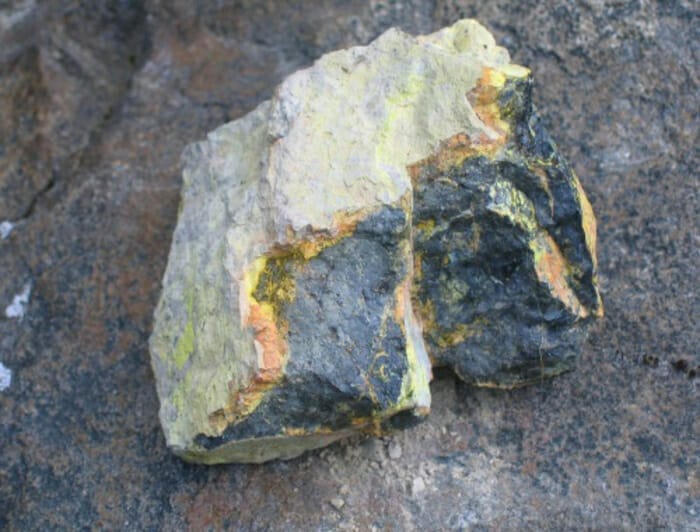
After completing a detailed airborne survey over Hook Lake back in April of this year, results were released on July 22nd via the following headline:
This press release is dense with data.
This current exploration effort could set the stage for an aggressive multiple-target (winter) drill campaign in Q4 of this year. We’ll start with the highlights at the top of the page:
- Airborne geophysical survey reinforces size potential of historic uranium occurrences and highlights additional targets across the Hook Lake Project:
- Both the VLF-EM and Magnetic data confirm extensive Northeast-Southwest (NE-SW) trending structural features as well as North-South (N-S) trending structures
- Data confirms known uranium showings are situated where these structural trends intersect and in close association with shallow VLF-EM conductors
- The N-S structural features may represent the influence of the Tabbernor Fault System, a major structural feature associated with known uranium deposits in the eastern Athabasca Basin
- “Heat maps” illustrating structural complexity highlighted additional areas for follow-up work
- Field work set to commence very shortly at the Hook Lake Project to follow up on new targets and historic uranium occurrences
- Work approvals received including approval for drilling
- Radiometric survey has commenced with coverage of the northeastern third of the Hook Lake Project and will be completed by the end of July
The above-noted confirmation of structural features and the points where they intersect – potent prospective traps for mineralization – will undoubtedly bolster confidence as Valor pushes Hook Lake further along the exploration curve.
Mr. George Bauk, Valor Executive Chairman:
“The survey has confirmed the key targets for immediate follow-up and has provided data to verify additional targets for drilling. Significant new geological information has come out of the survey including the N-S structural features, possibly representing the Tabbernor Fault System. These results have exceeded our expectations with the number of target areas to follow up. We have secured all permits that allow us to follow up on the ground, including drilling, which we are targeting for the December quarter. The field crew will be mobilising to site on July 23rd, 2021. The company is excited to be commencing field work in Saskatchewan and looks forward to the results of the exploration effort at Hook Lake.”
Airborne Magnetic and VLF-EM Survey:
This high-resolution, magnetic and VLF-EM survey ran property-wide. The 5,172-line kilometer survey was completed using a fixed-wing aircraft at a line spacing of 75 meters. “The purpose of the survey was to gather data that would help identify areas of shallow structural complexity, known to be favorable for the deposition of uranium in basement lithologies, and determine the geophysical signature of known occurrences.”
Geophysical Data Interpretation:
The geophysical data confirms extensive and complex structural trends across the property that could indicate structural and/or lithological traps for uranium mineralisation. Both the magnetic and VLF-EM data show a strong NE-SW structural trend similar to that present in other basement-hosted uranium deposits in the eastern Athabasca Basin area. A significant N-S structural trend is also present that has features similar to those associated with the Tabbernor Fault System.
Several of the known in-situ uranium occurrences on the property (Hook Lake, Nob Hill, and West Way – see news release dated October 22nd, 2020) are coincident with the intersection of these structural trends. The most significant uranium occurrences within the property also appear to have a close association with shallow VLF-EM conductors (map below). Several other conductors, that have previously seen little exploration and have no known nearby occurrences, also represent excellent prospects for follow-up exploration.
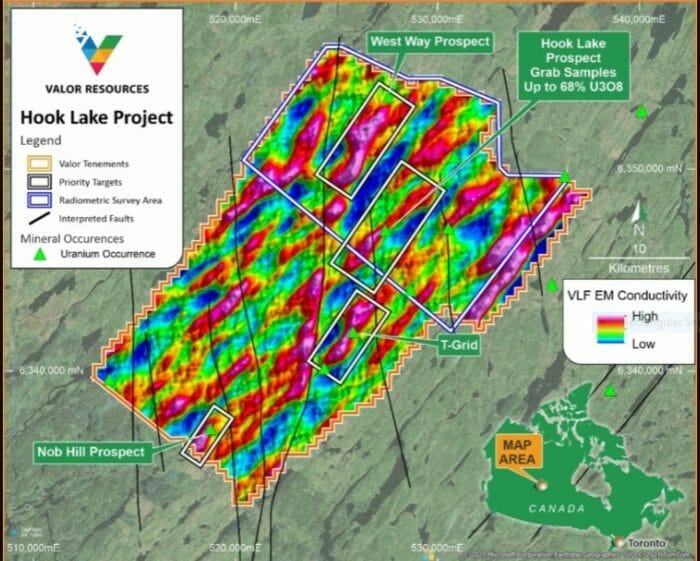
The magnetic data shows the Hook Lake mineralisation, with high-grade surface outcrop and reported grades in grab samples of up to 68% U3O8, may be part of a larger and broader anomalous zone than originally thought. 3D Inversion of the magnetic data indicates a potential feeder system coming up through the stratigraphy.
Tabbernor Fault System:
A North-South structural influence, similar to that recognized in the Tabbernor Fault System, could represent an important feature on the Hook Lake property. The Tabbernor Fault System is a wide structural feature that runs N-S along Saskatchewan’s eastern border for some 1,500 kilometers.
While there is no direct link between the Tabbernor system and current known uranium deposits, several deposits are associated with a N-S structural component within the sphere of influence of the Tabbernor system. It has been proposed that reactivation of the Tabbernor Fault System coincided with the formation of large uranium deposits in the Athabasca Basin and the Tabbernor system may have controlled deposit location. Deposits exhibiting N-S structural control, with features consistent with the Tabbernor system include Rabbit Lake (Collins Bay B Zone and Eagle Point), Dawn Lake, Midwest and the Sue deposit (reference Davies, J.R. (1998): The origin, structural style, and reactivation history of the Tabbernor fault zone, Saskatchewan, Canada; Masters thesis, McGill University, Montreal, Quebec, 105p.).
Airborne Radiometric Survey:
A high-resolution airborne radiometric survey is being flown over the historical high-grade uranium occurrence, along the northeastern third of the Hook Lake property. The team flying this survey—Special Projects Inc—flew the radiometric survey that delineated Fission Uranium’s PLS boulder field, which ultimately led to the discovery of the high-grade Triple R uranium deposit.
Significant new radiometric anomalies generated from this survey will be followed up during this summer’s field campaign.
Ground Field Work Program:
All of the required permits to put boots on the ground, and to drill, are in hand—the permits are good until the end of 2022.
Field work is set to commence in the next few days at the Hook Lake Project to follow-up on the historic uranium occurrences and new targets generated from the recently completed magnetic/VLF-EM survey. A field crew supported by a helicopter is being mobilised to the area to carry out a field program which will take 2-3 weeks.
The initial field work program will be conducted by Dahrouge Geological Consulting Ltd. Dahrouge Geological is a North American mineral exploration, consulting, and project management group with offices in Canada and the United States. They provide professional geological, logistical, and project management services to the world’s mining and mineral resource industry including project generation, program design, geophysics, project evaluation, geology & resources, as well as mine engineering and geotechnics. Dahrouge Geological has extensive exploration experience in Saskatchewan’s Athabasca Basin, with a consistent presence in the area since the early 2000’s; this experience and network of contacts makes Dahrouge Geological an ideal team to lead the exploration program on the Hook Lake Project.
At the bottom of this July 22nd press release, the prospective areas at Hook Lake hosting uranium mineralization were summarized thusly:
- Hook Lake / Zone S – High grade surface outcrop with reported grades in grab samples up to 68% U3O8; a bio-geochemical survey carried out over the trenches in 2015 responded positively with along-strike anomalies 2 kilometers to the northeast
- Nob Hill – Fracture-controlled vein-type uranium mineralisation on surface outcrop with up to 0.130% – 0.141% U3O8 in grab samples; diamond drilling intersected anomalous uranium in several drill holes with values up to 422 ppm U over 0.5 meters
- West Way – Vein type U mineralisation within a NE-trending shear zone; grab samples taken from the surface showing contained variable uranium values including up to 0.475% U3O8 and drilling of the structure intersected the altered shear zone at depth, along with anomalous Cu, Ni, Co, As, V, U, & Pb
- Grid T – Fracture-hosted secondary uranium mineralisation in sheared calc-silicates and marbles in a 100 m x 20 m zone of anomalous radioactivity with grab samples having up to 800 ppm U
- Alexander Lake Boulder Field – 30 biotite-quartz-k-feldspar pegmatite boulders NE of Alexander Lake; the best results include 360 ppm U, 1,400 ppm U and 1,600 ppm U respectively
- Thompson Lake Boulder Field – Numerous radioactive boulders and blocks of pegmatized meta-arkose, pegmatite, and granite; the best value obtained was 738 ppm U from a granite boulder
- NE Alexander Lake – Several calc-silicate, plagioclase-quartz granulite, quartzite, and meta-arkose boulders with up to 4,800 ppm U, 7,600 ppm Mo and 1,220 ppm Ni
The project area is in close proximity to grid power and two all-weather northern highways. Historical exploration consisted of airborne and ground geophysics, multi-phased diamond drill campaigns, detailed geochemical sampling + surveys, and ground-based prospecting culminating in an extensive geological database for the project area.
Simply put, drill targets at Hook Lake are being prioritized using good science via the very latest exploration technology, methods, and approaches.
Final thoughts
Activity in the Basin is beginning to accelerate for Skyharbour and its partner companies.
It shouldn’t be too long before we see initial results flow out of the Company’s flagship Moore Lake project.
Between Moore Lake, East Preston, and Hook Lake, expect assay-related newsflow well into the first half of 2022.
Skyharbour’s South Falcon Point project—the 2nd most advanced in the Company’s portfolio in terms of money spent and its position along the development curve—will also receive a proper probe with the drill bit this winter, whether it’s on the Company’s dime or via a new partner (details pending).
We stand to watch.
END
—Greg Nolan
Full disclosure: Skyharbour is an Equity Guru marketing client.

